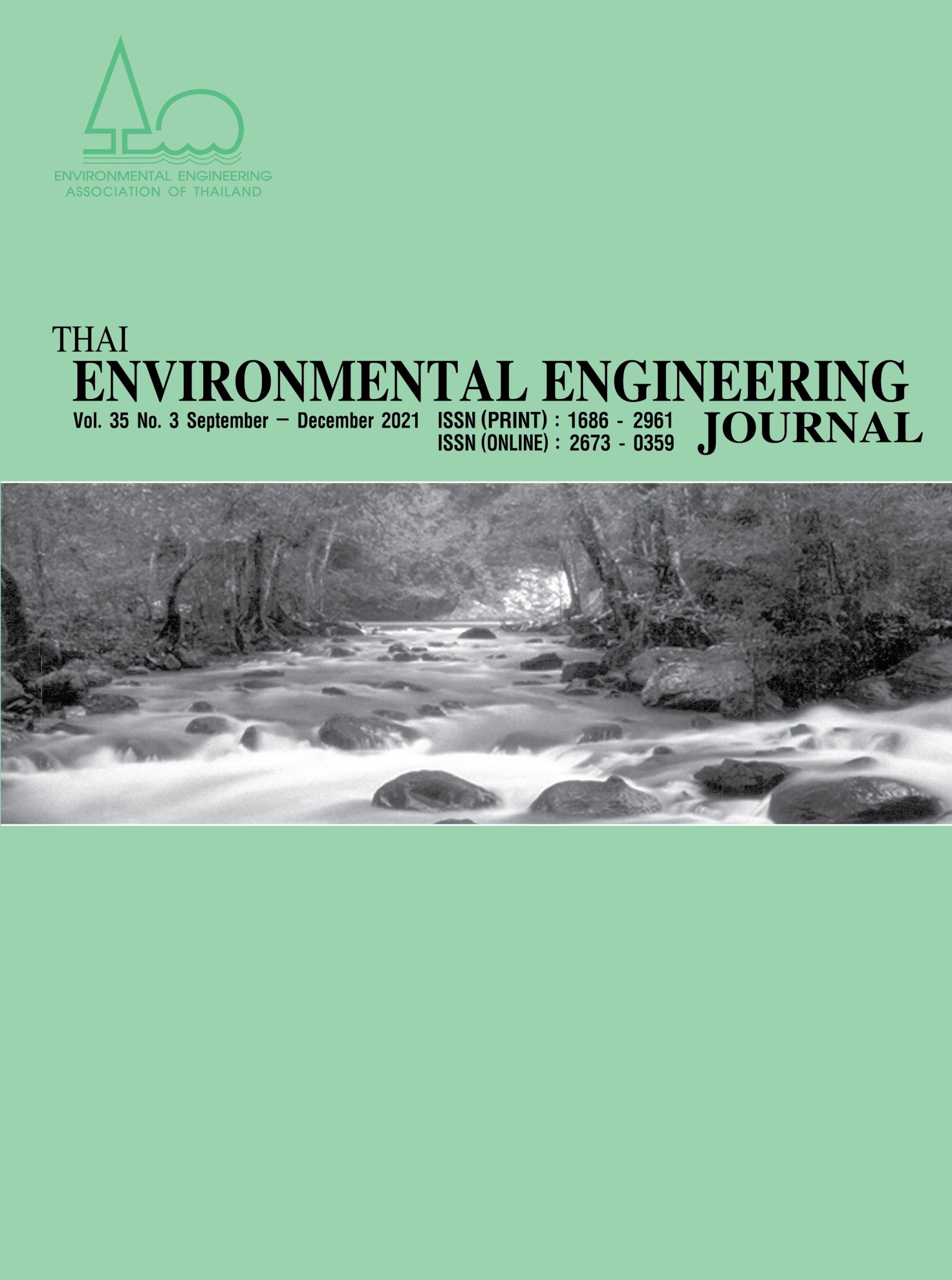Spatial and Temporal Distribution of Water Requirement by Major Crops in Chainat Province, Thailand
Main Article Content
Abstract
Water plays an important role in supporting agriculture. Accurate assessment of water requirements in terms of time, quantity, and space is critical for agriculture and food production sustainability. The objective of this study was to assess the spatial and temporal distribution of water requirements for major crops in Chainat Province, Thailand and identify the water shortage hotspots using a geographic information system (GIS). The spatial model was used to identify the crops plantation. Land use is divided into eight categories: rice, sugarcane, cassava, other agriculture, urban and built-up, forest, water bodies, and other lands. The result shows that the main land use in 2019 is for agriculture, accounting for about 85% of the total area. The main crops are rice, sugarcane, and cassava, accounting for 59%, 14%, and 8% of the total area, respectively. The model calculated the water requirements for those three main crops using the crop evapotranspiration, monthly climate data, and the existing water irrigation areas. The results were presented in a grid cell map of monthly crop water demand. The average water requirements of rice, sugarcane, and cassava are 9,675, 10,577 and 7,979 m3/ha, respectively. The water deficit areas for rice cultivation were Nong Mamong, Wat Sing, Hankha, and Wat Sing districts during February to March. In July, Noen Kham was found as the water deficit area for cassava and sugarcane cultivation. For the irrigation water requirement per year, rice requires around 5,612 m3/ha/two crop cycles, followed by sugarcane at about 4,322 m3/ha/crop cycle and cassava around 2,186 m3/ha/crop cycle. The substitution of rice cultivation by sugarcane or cassava in the water deficit areas could save water resources by about 1,289 and 3,426 m3/ha, respectively.
Article Details
References
Li, X., Tong, L., Niu, J., Kang, S., Du, T., Li, S. and Ding, R. 2017. Spatio-temporal distribution of irrigation water productivity and its driving factors for cereal crops in Hexi Corridor, Northwest China. Agricultural Water Management. 179: 55-63.
Gheewala, S.H., Silalertruksa, T., Nilsalab, P., Mungkung, R., Perret, S. and Chaiyawannakarn, N. 2014. Water Footprint and Impact of Water Consumption for Food, Feed, Fuel Crops Production in Thailand. Water. 6(6): 1698-1718.
Ngammuangtueng, P., Jakrawatana, N., Nilsalab, P. and Gheewala, S.H. 2019. Water, Energy and Food Nexus in Rice Production in Thailand. Sustainability. 11(20): 5852.
Bouman, B.A.M. and Tuong, T.P. 2001. Field water management to save water and increase its productivity in irrigated rice. Agricultural Water Management. 49(1): 11-30.
Mungkung, R., Gheewala, S.H., Silalertruksa, T. and Dangsiri, S. 2019. Water footprint inventory database of Thai rice farming for water policy decisions and water scarcity footprint label. The International Journal of Life Cycle Assessment. 24(12): 2128-2139.
Nilsalab, P., Gheewala, S.H. and Mungkung, R. 2012. Water Assessment of agrofuels feedstock cultivation: Methodology approaches. Environment and Natural Resources Journal. 10(2): 11-20.
Silalertruksa, T. and Gheewala, S.H. 2018. Land-water-energy nexus of sugarcane production in Thailand. Journal of Cleaner Production. 182: 521-528.
Kaenchan, P. and Gheewala, S.H. 2012. A review of the water footprint of biofuel crop production in Thailand. Journal of Sustainable Energy and Environment. 4: 45-52.
Hadour, A. Mahe, G. and Meddi, M. 2020. Watershed based hydrological evolution under climate change effect: An example from North Western Algeria. Journal of Hydrology: Regional Studies. 28: 100671.
Liu, S., Luo, G. and Wang, H. 2020. Temporal and Spatial Changes in Crop Water Use Efficiency in Central Asia from 1960 to 2016. Sustainability. 12(2): 1-18.
Huynh, V.M., Hong, S., Kwon, Y., Tran, V.T., Huynh, V.T.M. and Kwon, S. 2021. An optimal rain-gauge network using a GIS-based approach with spatial interpolation techniques for the Mekong River Basin. Journal of Coastal Research. 114(sp1): 429-433.
Choudhury, M.R., Mellor, V., Das, S., Christopher, J., Apan, A., Menzies, N.W., Chapman, S. and Dang, Y.P. 2021. Improving estimation of in-season crop water use and health of wheat genotypes on sodic soils using spatial interpolation techniques and multi-component metrics. Agricultural Water Management. 255: 107007.
Karandish, F., Hoekstra, A.Y. and Hogeboom, R.J. 2020. Reducing food waste and changing cropping patterns to reduce water consumption and pollution in cereal production in Iran. Journal of Hydrology. 586: 124881.
Allen, R.G., Pereira, L.S., Raes, D. and Smith, M. 1998. Crop evapotranspiration: guidelines for computing crop water requirements. FAO Irrigation and drainage paper 56. Food and Agriculture Organization, Rome. Italy.
Royal Irrigation Department (RID). 2011. Reference Crop Evapotranspiration by Penmen Monteith (Second edition). Irrigation Water Management Dissemination Branch, Irrigation Water Division, Office of Hydrology and Water Management, Royal Irrigation Department: Bangkok, Thailand.
Yang, X., Xie, X., Liu, D.L., Ji, F. and Wang, L. 2015. Spatial Interpolation of Daily Rainfall Data for Local Climate Impact Assessment over Greater Sydney Region. Advances in Meteorology. 2015: 1-12.
Royal Irrigation Department (RID). 2015. Geo Manual for calculating rainfall [Online]. Available at: http://idi.rid.go.th/training/2558/Volume%2006.pdf [Accessed on 14 July 2021].
Brouwer, C. and Heibloem, M. 1986. Irrigation water management: Irrigation water needs, Training Manual no. 3 (Chapter 3 & Chapter 4). Food and Agriculture Organisation (FAO). Rome, Italy.
Kyei-Mensah, C., Kyerematen, R. and Adu-Acheampong, S. 2019. Impact of Rainfall Variability on Crop Production within the Worobong Ecological Area of Fanteakwa District, Ghana. Advances in Agriculture. 2019: 1-7.
Mango, N., Makate, C., Tamene, L., Mponela, P. and Ndengu, G. 2018. Adoption of Small-Scale Irrigation Farming as a Climate-Smart Agriculture Practice and Its Influence on Household Income in the Chinyanja Triangle, Southern Africa. Land. 7(2): 49.
Burke, M.B., Lobell, D.B. and Guarino, L. 2009. Shifts in African crop climates by 2050, and the implications for crop improvement and genetic resources conservation. Global Environmental Change. 19(3): 317-325.
Elliott, S., Chairuangsri, S., Kuaraksa, C., Sangkum, S., Sinhaseni, K., Shannon, D., Nippanon, P. and Manohan, B. 2019. Collaboration and Conflict-Developing Forest Restoration Techniques for Northern Thailand’s Upper Watersheds Whilst Meeting the Needs of Science and Communities. Forests. 10(9): 732.


